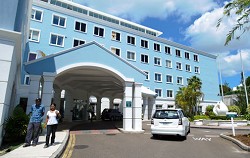By Sam Strangeways
Hospital authorities have revealed information about 13 adverse events in the past five years which, in some cases, led to the death or permanent injury of patients.
The Bermuda Hospitals Board disclosed the information in response to a public access to information request from The Royal Gazette for details of all “serious or untoward incidents” at King Edward VII Memorial Hospital since 2011.
There were two such events in 2011, one in 2012, five in 2013, two in 2014 and three in 2015, according to the board.
The list provided shows that of the 13 patients involved in the incidents, five died as a result of the hospital’s actions and one, who was given surgery on the wrong part of their body, died as a result of their original ailment.
One patient suffered permanent harm and another long-term harm which was potentially permanent. In one case there was no adverse outcome to the patient, while four patients suffered temporary harm and made a full recovery.
Although this newspaper asked for details of each event, the BHB shared limited information on the circumstances. In three of the cases where patients died as a result of the hospital’s actions, there was a delayed or missed diagnosis. In another fatal case, a patient fell and the hospital concluded that the event was “likely unpreventable”.
A fifth fatal case was described as a “monitoring event” which prompted the development of “improved monitoring procedures” at KEMH.
In the case involving permanent harm, a patient fell. The incident led to a review of the process for patient’s getting permission to leave a clinical unit and “strengthened communication” among staff.
The case which resulted in long-term harm involved a surgical site infection and led to an “intensive review to identify a definitive cause” though no cause was identified. The hospital also made “small changes to possibly prevent future recurrences” after a general review of all infection control practices.
One incident involved a patient who developed ABO incompatability, a red blood cell disease usually caused by a transfusion of the wrong blood type.
The individual came to no harm but the case prompted “re-education” throughout the hospital on “blood product compatibility”.
A BHB spokeswoman told this newspaper: “BHB welcomes the opportunity to share accurate data, whether through Pati or its own regular reporting. We want patients to know they also are part of the solution for higher quality care.
“No hospital has yet achieved the much desired zero patient harm figure, so wherever your health challenges take you, at BHB or overseas, ask questions, raise concerns, point out anything that doesn’t seem right.”
She said patient safety was the BHB’s number one priority and it saw any incident of patient harm as “unacceptable”.
“Like BHB, hospitals around the world work hard to avoid incidents of patient harm, but no hospital has yet resolved how to do so completely,” said the spokeswoman. “It has been, however, much more common for adverse event information to be published in many countries and this has helped drive patient safety initiatives. Our hope is that it will be no different here in Bermuda.”
Our Pati request asked for information on all events at KEMH since 2011 recorded under any of the following widely-used hospital terms: sentinel, never, potentially compensatable, patient safety or adverse.
Debra Goins Francis, information officer for the BHB, told this newspaper: “Sentinel events in hospitals are rare yet when they occur it is devastating for families. We have looked at sentinel events over the past five years at BHB and have provided 13 events that fall into this category.
“This information should not be looked at in isolation as BHB is not [a] unique hospital environment.”
According to the World Health Organisation, European data, mainly from European Union member states, consistently shows that medical errors and healthcare related adverse events occur in 8 to 12 per cent of hospitalisations.
The UK’s Department of Health reported in 2000 that an estimated 850,000 adverse events took place annually, amounting to 10 per cent of hospital admissions.
KEMH’s rate of adverse events appears to be far lower but the BHB spokeswoman noted that it was “not easy” to accurately compare the Island’s only hospital to hospitals in larger jurisdictions.
“Our service profile is different to many hospitals because we are isolated, even when the number of beds or admissions and discharges are similar. For example, in emergency situations, BHB has to be able to stabilise and care for all people who are seriously ill or injured, even those who need specialist care overseas.”
The board does not provide statistics on admissions but rather discharges for KEMH. There were 5,737 discharges between April 2014 and March 2015.
The 13 adverse events at the hospital over five years suggests an average of 2.6 a year — or 0.04 per cent of discharges.
Ms Goins Francis said the BHB used Accreditation Canada’s definition of a sentinel event as: “An adverse event that leads to death or major and enduring loss of function for a recipient of healthcare services. Major and enduring loss of function refers to sensory, motor, physiological, or psychological impairment not present at the time services were sought or began.”
Accreditation Canada’s website says it has adopted the World Health Organisation’s classification of a patient safety event as any event or circumstance that could have resulted, or did result, in unnecessary harm to a patient, including harmful incidents, no harm incidents and near misses.
The Joint Commission in the United States, which accredits some 21,000 healthcare organisations, reported 764 sentinel events for 2014 — with the most reported events included unintended retention of a foreign object (112) and falls (91). Wrong-site, wrong-patient and wrong-procedure surgery accounted for 67 events. (The Royal Gazette)














